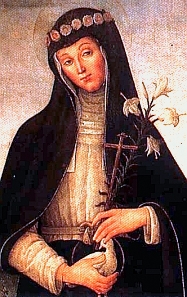Columba of Rieti facts for kids
Quick facts for kids BlessedColumba of Rieti TOSD |
|
|---|---|
 |
|
| Virgin | |
| Born | 2 February 1467 Rieti, Umbria, Papal States |
| Died | 20 May 1501 (aged 34) Perugia, Umbria, Papal States |
| Venerated in | Roman Catholic Church (Dominican Order) |
| Beatified | 25 February 1625 by Pope Urban VIII |
| Feast | 20 May |
| Attributes | Dominican tertiary receiving the Eucharist from a hand reaching down from heaven; Dominican tertiary with a dove, lily, and book, or a wreath of roses, cross, lily, and a rosary |
Blessed Columba of Rieti (born Angelella Guardagnoli, 2 February 1467 – 20 May 1501) was an Italian religious sister. She belonged to the Third Order of St. Dominic. Columba was known as a mystic, someone who had special spiritual experiences.
People admired her for her wise advice and strong faith. She was especially devoted to the Blessed Sacrament. Many amazing things, like miracles, were said to have happened because of her. The Catholic Church officially recognized her as "Blessed" in 1625.
Columba's Story
Her Early Years
Columba was born Angelella Guardagnoli in 1467. Her family was not rich and lived in Rieti, a city in Umbria. A legend says that when she was born, angels sang around her home. Another story tells that a dove flew to the baptism font during her baptism. Because of this, people started calling her Columba, which means "dove."
As a young girl, Columba learned to spin and sew. She often mended clothes for the local Dominican friars. Dominican nuns also taught her. When she was a teenager, she prayed to understand what God wanted her to do. She then had a vision of Jesus on a throne surrounded by saints.
Columba believed this vision meant she should give her life to God. So, she made a private promise to stay pure and spent her time praying. When her parents arranged a marriage for her, she cut off her hair. She sent it to her suitor to show him she wanted to serve God, not marry.
Life as a Religious Sister
At age 19, Columba joined the Dominican Third Order. She was known for having deep spiritual experiences. During one of these, it was said her spirit visited the Holy Land. Many people sought her advice on spiritual matters.
People from the city of Narni even tried to take her away. They wanted her to be "their" miracle worker. But Columba managed to escape. She often fasted as a way to show her deep faith. She also practiced self-discipline, like wearing a hairshirt. This was a common way for holy people in her time to show their devotion.
Columba felt called to leave Rieti. She began to travel without knowing where she was going. She was stopped in Foligno because she seemed to be a wanderer. The bishop there told her to go to Perugia. He asked her to start a new convent for the Third Order.
She did this, even though people from Foligno and Rieti wanted her to stay in their towns. In Perugia, she worked hard helping the poor. Her holy life was so clear that it bothered some powerful people. Lucrezia Borgia even accused Columba of practicing magic. However, Pope Alexander VI, Lucrezia's father, respected Columba greatly. He even asked her for advice and received a strong message to change his ways.
Columba served as the leader, or prioress, of the convent in Perugia for eleven years. She passed away on May 20, 1501, at 34 years old. A legend says that when she died, her friend, Blessed Osanna of Mantua, saw Columba's soul rise to heaven like a bright light. The whole city of Perugia attended her funeral. The city leaders even paid for it.
Columba was beatified on February 25, 1625, by Pope Urban VIII. Her feast day is celebrated every year on May 20 within the Dominican Order.
See also
- Blessed Stephana de Quinzanis
- Blessed Osanna of Mantua

